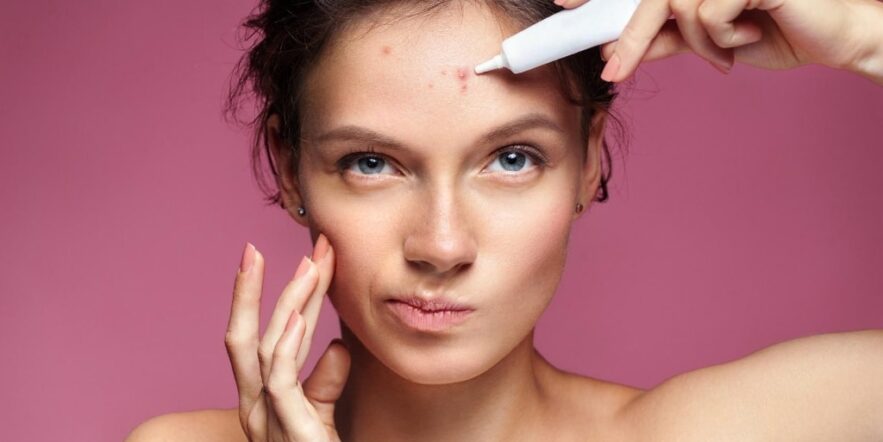<iframe width=”1266″ height=”712″ src=”https://www.youtube.com/embed/zLHCU3XZkvc” title=”Skincare Facts & Tips – How to Get Rid of Acne…Tip 1: No Pimple Popping | Treatments & Medicines” frameborder=”0″ allow=”accelerometer; autoplay; clipboard-write; encrypted-media; gyroscope; picture-in-picture; web-share” referrerpolicy=”strict-origin-when-cross-origin” allowfullscreen></iframe>
The primary cause of acne is clogged pores. Your pores can be clogged by bacteria, dead-skin cells or sebum, an oily substance secreted by your skin. The clogs cause redness and inflammation, which can be painful. Some doctors and patients believe that our diets can be the root cause of certain types of acne, but, for the most part, our lifestyles and hygiene are not to blame. Many women experience hormonal acne, which flares up at specific times during their menstrual cycles, or because of hormonal conditions, such as polycystic ovarian syndrome (PCOS), a disorder that affects many women.
What Are the Different Types of Acne?
Acne comes in many shapes and forms, and you can have multiple types of pimples at the same time.
Blackhead: a pimple with a black tip. It is a clogged hair follicle that has reached the surface of the skin, where the sebum becomes discolored.
Whiteheads: a pimple with a white tip. It’s a clogged hair follicle that stays below the surface of the skin.
Papules: inflamed pimples that turn into pink or red bumps. They can be tender to the touch.
Pustules: papules with white or yellow pus on top.
Cystic Acne: painful pimples filled with pus that are deep within the skin.
Side Effects of Topical Acne Medicines
Many face washes, moisturizers, spot treatments and other skincare products designed to treat acne are available both over the counter (OTC) and as prescriptions from your dermatologist or other healthcare provider. If you’re buying a treatment without a prescription, make sure you check the ingredients list for the drugs, listed below, before you purchase one and that you know how much of it is used in the product. Meanwhile, if a provider gives you a prescription, make sure you two discuss any other topical products you’re already using to ensure they won’t interact.
If you experience redness after using a new product, for example, you may, at your healthcare provider’s recommendation, switch to one with the same active ingredient in a lower concentration.
Topical Benzoyl Peroxide: Benzoyl peroxide is the active ingredient in some OTC products designed to treat acne, such as Stridex and Clearasil. It kills bacteria that can clog your pores and make acne worse. A 2020 Cochrane Review of 120 clinical trials suggests that people who used the treatment were more likely than those who used a placebo to report that their acne had cleared up. Benzoyl peroxide is sometimes combined with topical antibiotics, such as clindamycin and erythromycin, to enhance its effects.
If your skin is slightly irritated—a little red or peeling more than usual—it’s important to keep it moisturized. In addition to your normal moisturizer, you may find that applying aloe vera is soothing. Anna Chacon, MD, a dermatologist with MyPsoriasisTeam, an online support group for those with psoriasis, adds that the medication can make your skin more sensitive to the sun. If you’re using that product, sun protection is especially important.
Salicylic Acid: Salicylic acid works by dissolving dead-skin cells and encouraging new-skin growth to replace your top layer of skin. This helps unclog pores and prevent acne before it gets inflamed. The most common side effects are skin irritation and stinging. If you reduce your frequency of use, these side effects will likely lessen over time.
Azelaic Acid: Azelaic acid has antibacterial properties and is produced by yeast. Enrizza Factor, MD, a dermatologist at My Eczema Team, an online support group for those with vitiligo, says that creams or gels with at least 20% azelaic acid used twice a day “seem to be as effective as many conventional acne treatments. The drug comes in prescription form – Azelex and Finacea. It’s commonly prescribed for women in need of acne treatment while pregnant or breast-feeding. Like many treatments, it can cause skin redness and irritation.
Topical Spironolactone: Spironolactone, which blocks androgen hormones, exists as both a topical and oral medication. While it was originally approved for heart failure and high blood pressure, it’s often prescribed for hormonal acne, especially in women who have been diagnosed with PCOS. While oral spironolactone comes with several side effects, some people may tolerate the topical application better.
Topical Retinoids: Retinoids are drugs derived from vitamin A. Some examples of retinoids are Avita, Retin-A, Differin (adapalene) and Tazorac (tazarotene.) Many dermatologists prescribe powerful retinoids, but less potent versions are available OTC. Similar to salicylic acid, retinoids work by encouraging new-skin growth to replace your top layer of skin. This helps unclog pores and prevent acne before it gets inflamed. Factor adds that you shouldn’t use retinoids at the same time as products that contain benzoyl peroxide because they can reduce each other’s impact while simultaneously irritating your skin.
Many people find that their skin becomes red, dry and irritated when they start using retinoids. If this happens, doctors recommend using them every other day or a few times a week instead of daily. Retinoids can also make your skin more sensitive to ultraviolet light from the sun, so it’s especially important that you use sunscreen or cover your skin when you step outside.
Dapsone: Dapsone is an antibiotic that can help treat inflammatory acne. Your provider may prescribe it if other treatments haven’t been effective for you. Like many topical acne medications, dapsone can cause dryness, redness or skin irritation. It’s unusual, but if you experience other side effects, like blue lips, nails or mouth or shortness of breath, call your doctor immediately.
Side Effects of Oral Acne Medications
Oral Contraceptives: Hormonal changes can cause acne, and many women experience breakouts before their periods. Acne is a common symptom of PCOS. Some people with acne flare-ups related to hormonal changes are prescribed combined oral contraceptives (birth control pills that contain both the hormones estrogen and progesterone) in hopes that the medicine will help regulate their hormones and reduce acne.
A 2012 Cochrane Review of 31 studies suggests that the drugs did reduce the severity of acne overall. Individuals taking the pills experienced a reduction in pimples and inflammation. However, it’s unclear which formulations are the most effective. If you have PCOS, your doctor may prescribe a combination of oral contraceptives and metformin, a drug normally prescribed for diabetes.
A 2021 analysis of 51 studies suggests that metformin, prescribed either alone or in conjunction with another therapy, did improve the symptoms of acne in women with PCOS. Metformin is an older diabetes drug that has been on the market since 1995. It is often considered one of the safest drugs for the condition. Insulin resistance is common in women with PCOS, even if they don’t have diabetes, and the drug can help restore insulin sensitivity. Still, like any drug, it does have side effects.
Common side effects of oral contraceptives include:
- Spotting between periods
- Migraines
- Fluid retention
- Nausea
- Breast tenderness
- Blood clots
- Other side effects, like depression, may be common, but research on it is limited.
Metformin side effects:
- Nausea, diarrhea, vomiting
- Birth defects, if taken while a man is producing sperm
Spironolactone: As mentioned above, is an anti-androgen drug that is sometimes prescribed for hormonal acne in women. Acne treatment is an off-label use of the drug, which the Food and Drug Administration (FDA) first approved in 1960 to treat heart failure and high blood pressure. However, for many years now, it’s been commonly used to treat acne. It works by blocking androgen hormones that affect your oil-producing glands. It comes as prescribed creams or oral spironolactone pills. The pills may be more effective, but they also come with more side effects.
Side effects of oral spironolactone include:
- Breast tenderness
- Painful periods
- Excessive urination and dehydration
- Reduced blood pressure
- Fatigue
- Anxiety
Accutane (isotretinoin): The company that manufactures Accutane has discontinued the drug, but generic versions exist. Many people are still familiar with Accutane, which is an oral retinoid that works by shrinking your oil glands. It’s “only used for the most severe cases of acne,” explains Chacon, because as one writer for The Atlantic referred to it, “the scorched-Earth” acne treatment comes with a host of side effects. Still, many patients, such as Mark McShane, a first-aid-course director, say the drug is highly effective. “I’ve used multiple treatments,” says McShane. “The one that worked best was Accutane.”
Side effects of isotretinoin:
Doctors usually prescribe a five-month course of treatment during which women are required to sign a pledge to use contraception because the drug can cause miscarriages and birth defects. Some reports have linked the drug to depression and suicidal thoughts, though experts caution that it’s unclear whether this is caused by the drug, severe acne or another situation.
As children are entering puberty younger and younger, more of them are experiencing acne. Most acne medications have been tested and approved for individuals 12 and older. Guidelines from the American Academy of Dermatology state that topical benzoyl peroxide, adapalene and tretinoin can safely be used in children before puberty. Still, Factor emphasizes that if your child is looking for acne treatment, it’s ideal to find a pediatric dermatologist, who is likely to understand the unique effects of these drugs and their safety in children.






